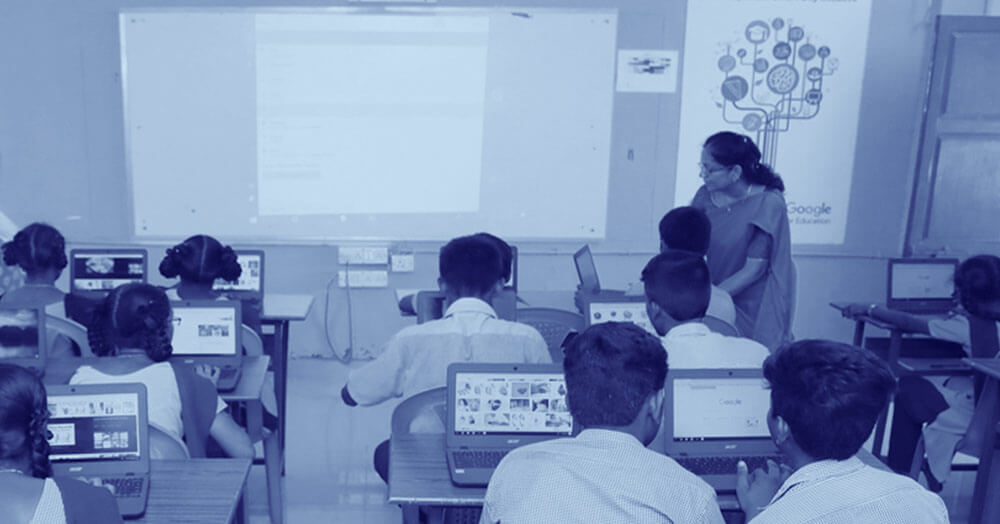Blogs
What does the future of Smart Classrooms look like?

In today's fast-changing digital world, technology plays a big role in our everyday lives, even education. As schools move away from old-fashioned setups to more modern ways of learning, smart classroom have become a big deal in education.
But what are smart classrooms, and how do they change education? Let's look at what smart classrooms are, and how they've evolved. What benefits do they bring to education?
What are Smart Classrooms?
Imagine stepping into a classroom where every corner is buzzing with interactive technology and digital wizardry. Which is what we call a "smart classroom." These cutting-edge educational spaces are decked out with multimedia displays, digital content, and tools for collaboration. They're like dynamic playgrounds for learning, tailored to suit different learning styles.
In a nutshell, smart classrooms aren't just classrooms – they're glimpses into the future of education.
What are the key features of Smart Class?
1. Interactive Whiteboards and Multimedia Displays
One of the digital learning solutions for schools of smart classrooms is the integration of interactive whiteboards and multimedia displays. These advanced technologies replace traditional blackboards and projectors allowing educators to present content in dynamic and engaging ways. Interactive whiteboards enable teachers to interact directly with digital content, annotate materials, and facilitate interactive lessons.
Schoolnet's smart classroom solutions like KYAN and Geneo enhance visual learning experiences by incorporating videos, animations, and interactive simulations. To make lessons more immersive and memorable for students.
2. Digital Content and Educational Software
In smart classrooms, you'll find a myriad of digital tools like e-books, educational videos, and interactive modules. All are designed to amp up teaching and learning. These resources give educators a wealth of materials to spice up their lessons and meet the needs of every type of learner.
Additionally, Geneo by Schoolnet comes packed with fun tools and apps that get students thinking, solving problems, and working together – all essential skills for the future.
3. Collaborative tools and online resources
In smart classrooms, collaboration is king, thanks to tech-savvy tools and online resources. Students can team up, brainstorm ideas around, and work with classmates and teachers in real time. Virtual classrooms, discussion boards, and cloud storage make it easy to collaborate and chat, no matter where you are. By encouraging teamwork, smart classrooms help students build crucial skills like communication and working together – skills they'll need to thrive in today's digital world
4. Personalized Learning Experiences
Smart classrooms offer a major perk: personalized learning. This means students get to learn in a way that suits them best. They can go at their speed and tackle topics in their preferred style. By tailoring learning to each student, smart classrooms boost engagement, motivation, and success.
5. Advanced Labs and Training Facilities
Smart classrooms are packed with cutting-edge digital learning solutions for schools and facilities tailored for subjects like Robotics, AI, Coding, and more. These spaces offer hands-on learning, sparking creativity and problem-solving skills in students.
Language Labs take learning to the next level, offering immersive experiences in both English and Foreign Languages, boosting communication skills. And for budding engineers, Robotics training programs make learning interactive and fun, introducing kids to the world of robots in an engaging way.
Why do Smart Classrooms work?
- Students get more engaged and motivated.
- Learning outcomes and grades get a boost.
- Getting you ready for the future job market with top-notch skills.
- Loads of digital content and educational apps at your fingertips.
- Learning that's all about you – personalized to fit your style.
- Teachers become even more efficient at what they do.
- Less time on paperwork, more time for productive teaching moments.
- Building a culture where innovation and teamwork rule.
What lies ahead for Smart Classrooms?
A. Emerging technologies shaping the future of smart classrooms
The next frontier for smart classrooms is powered by cutting-edge tech like virtual reality (VR), augmented reality (AR), and artificial intelligence (AI). These breakthroughs bring immersive learning and personalized teaching to the table. AI will customize lessons just for you, while VR and AR will whisk you away to interactive worlds for deeper learning.\
B. Advancements in personalized learning and adaptive instruction
As AI advances, personalized learning and adaptive teaching will get even better. AI algorithms will study student info to suggest customized learning paths and offer instant help. Teachers will understand student progress better, leading to smarter teaching methods and support when needed.
C. Opportunities for collaboration and global connectivity
In the future of smart classrooms, collaboration and global connections take the spotlight. Online platforms and virtual classrooms will link students across the globe, sparking cultural exchanges and teamwork. With better communication tech, the collaboration will flow effortlessly, letting students and teachers swap ideas and materials worldwide, shaping a more connected and cooperative learning atmosphere.
In Conclusion
In a nutshell, smart classrooms mark a game-changing moment in education, using tech to craft lively and captivating learning spaces. From interactive whiteboards to tailored learning, they bring heaps of perks for teachers and students alike. Looking forward, the sky's the limit for innovation in smart class, with VR and AI set to shake up how we teach and learn.
By embracing this future and keeping an eye on adaptability and inclusivity, educators and schools can help students thrive and get ready for whatever the world throws their way.






